Medieval Protective Armor
Protective armor in the Middle Ages was designed to absorb or deflect physical attacks while staying as mobile and flexible as possible. The protection developed as the weapons used in battle evolved.
Chain Mail / Hauberk
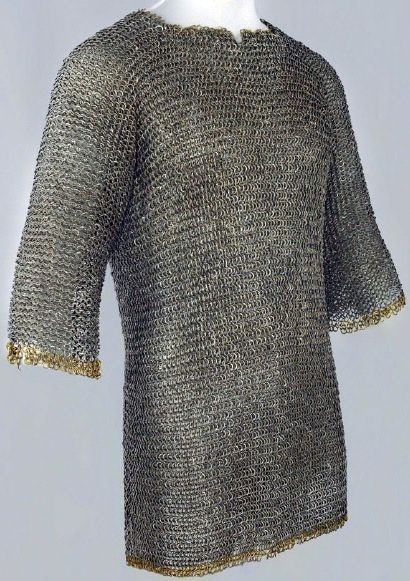
A type of armor consisting of small metal rings linked together in a four-in-one pattern to form a mesh. The rings would be riveted together to reduce the chance of them splitting open when subjected to a thrusting attack or hit by an arrow.
Chain mail was used for over a thousand years and protected the wearer from stabbing and slashing attacks as the metal loops would absorb the strike and prevent the blade from penetrating the skin. Concussions, bruising, and broken bones were still possible, so padding was usually worn under the mail.
There were different terms for each type of garment made from mail. A hood was called a mail coif, leggings were chausses, mittens were mitons, and a mail collar hanging from a helmet to protect the neck was an aventail. A mail shirt was a hauberk if it hung down to the knee, and a haubergeon if mid-thigh length. Chain mail stitched between two layers of cloth was called a jazerant.
Chain mail became a secondary method of protection in the 14th century when articulated plate armor was more common. However, it still gets used today to protect butchers from cuts, animal control officers from animal bites, and scuba divers to protect against shark bites.
Plate Armor

A type of body armor made from iron, steel, or bronze, fully encasing the wearer, the classic suit or armor of a medieval knight. Full plate armor developed in Europe during the Late Middle Ages and the Hundred Years' War from the coats of plates worn over chainmail during the 14th century.
Full suits of Gothic armor were worn during the Burgundian Wars, Wars of the Roses, Eighty Years' War, French Wars of Religion, Italian Wars, Ottoman-Habsburg Wars, Hundred Years' War, and the Thirty Years' War.
A full suit of plate armor would weigh around 30 to 60 pounds, and the wearer would remain agile as the weight was distributed throughout the body. The armor was articulated, allowing the wearer to move and bend.
Plate armor declined with the introduction of gunpowder and firearms, whose bullets could penetrate the steel. From then on, armor was restricted to jousting tournaments or decorative armor for parades.
The different parts of a suit of plate armor are covered below:
Helmet

The helmet was the most essential part of the suit of armor as it protects the head. Helmets came in various styles based on the period and were worn with plate mail, chain mail, or on their own with some cloth protection for the body.
Helmets were made from iron or steel and consisted of various parts:
- The skull protects the top of the head.
- The visor was the movable part covering the face.
- The bevor which protected the neck and chin.
The next section breaks out Medieval helmets in various styles and chronological order.
Aventail / Camail
A flexible curtain of chain mail attached to the skull of a helmet. The aventail helps protect the neck and sometimes the shoulders. Part of the face could also be covered, with a gap by the eyes to allow vision. Aventails were commonly used on bascinet-style helmets and served as a replacement for the mail coif.
Bevor / Falling Buffe
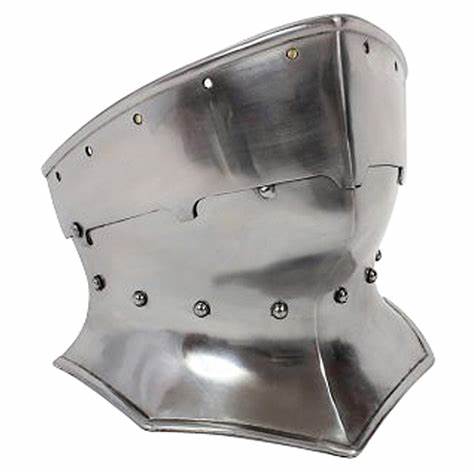
A single piece of plate armor that protects the chin and throat, much like a gorget that fills that gap between the helmet and the breastplate.
The bevor was initially worn with the sallet-style helmet and fastened to the breastplate. As helmets evolved to the close helm and burgonet, the bevor became a hinged plate attached to the helmet.
In the 16th century, the bevor evolved into the falling buffe, which was made up of several articulated lames that could be raised and lowered for better ventilation when not in battle.
Gorget
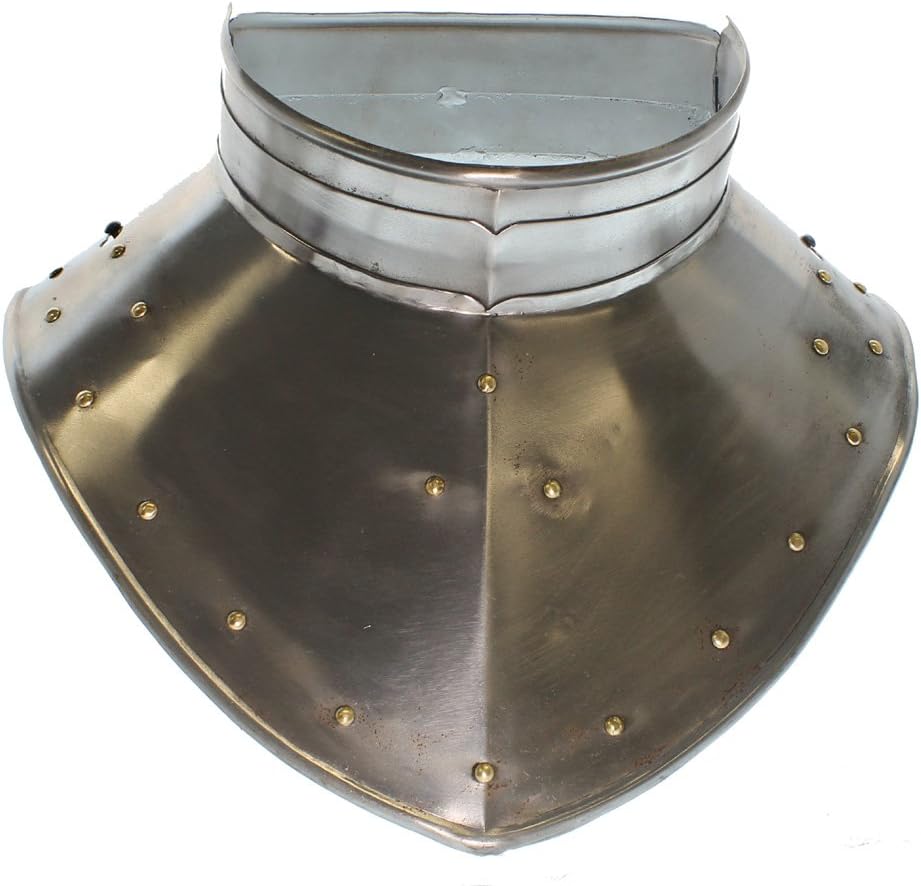
A steel collar to protect the neck and cover the neck opening in a cuirass. It also covers the clavicles, sternum, and part of the upper back. Gorgets were developed to enhance the protection from breastplates as lances evolved to penetrate plate armor.
The gorget was a standing color plate separate from the helmet worn over the aventail, with enough space so a man-at-arms could still turn his head.
In the 16th century, the gorget reached its final iteration as a part of plate armor. The gorget was now worn under the cuirass, covered a larger area of the neck, shoulders, and upper chest, and served as an anchor point for pauldrons. A high collar of articulated lames protected the neck, and the gorge was divided into front and back parts hinged at the side.
Standard / Pisan

A collar of chain mail often worn with plate armor between the 14th and 16th centuries. The standard protected the throat and neck and usually extended over the shoulders. It was similar to the aventail but was not fastened to the helmet. They were frequently worn with helmet styles that did not provide neck or throat protection, such as kettle hats, nasal helmets, sallets, and barbutes.
Standards were primarily worn without other neck protection by soldiers who needed the ability to move their heads, such as archers. However, they were sometimes worn under an aventail or a gorget for extra protection.
Cuirass / Breastplate / Backplate
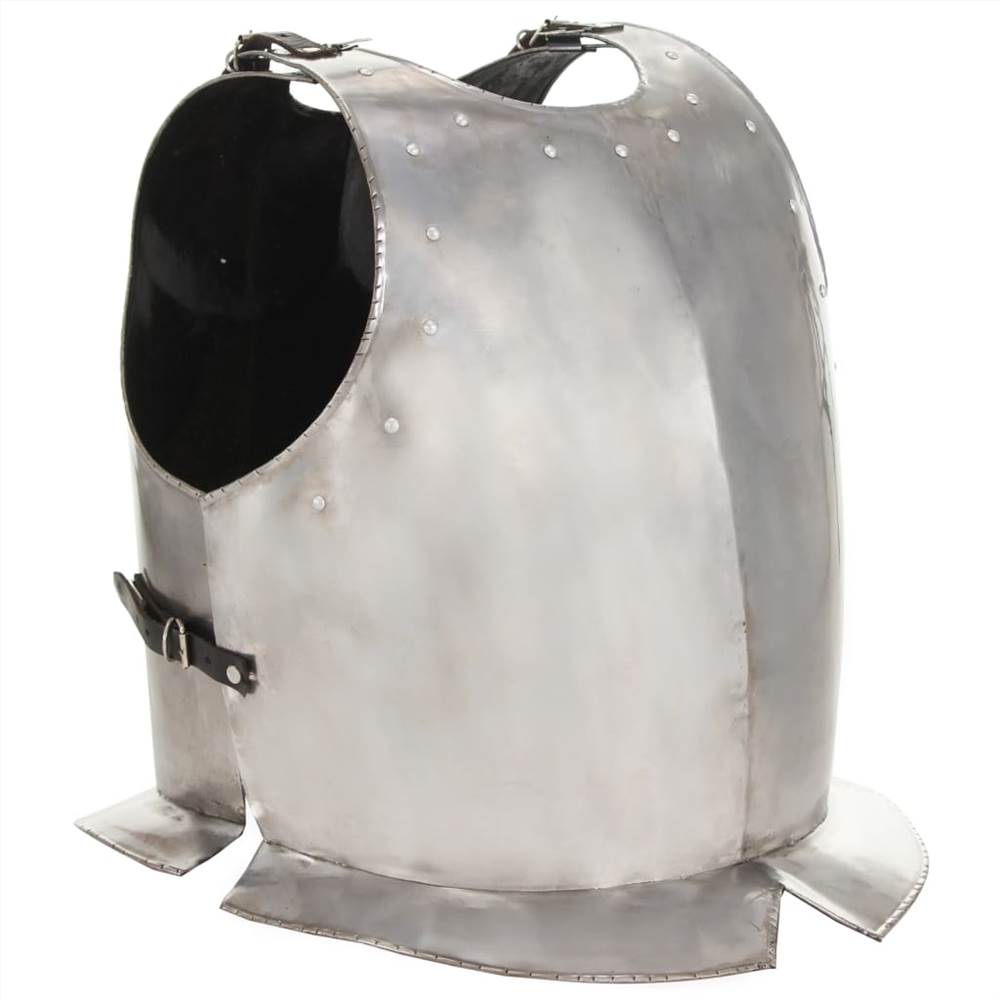
A piece of plate armor that covers the torso. The cuirass refers to both the breastplate and backplate, used in combination to protect the whole torso of the wearer. Where the breastplate only protects the front.
Mail hauberks were used to protect the torso on men-at-arms until the 14th century when plate armor became the standard, and the cuirass was developed.
The cuirass was made of one or more pieces of metal and did not extend to the hips. Instead, they stopped around the midriff or naval, allowing the wearer a better range of movement. To protect the gap from the midriff to the legs, a plackart was attached to the cuirass or a mail hauberk was worn underneath the plate armor. A cuirass's breast and back plates were typically attached using leather straps over the shoulders and more straps under the arms and near the midriff.
The effigy of the Black Prince in Canterbury Cathedral from 1376 depicts him wearing a cuirass with a hauberk covered by the royalty-emblazoned jupon, or surcoat, of the Prince.
Plackart / Faulds
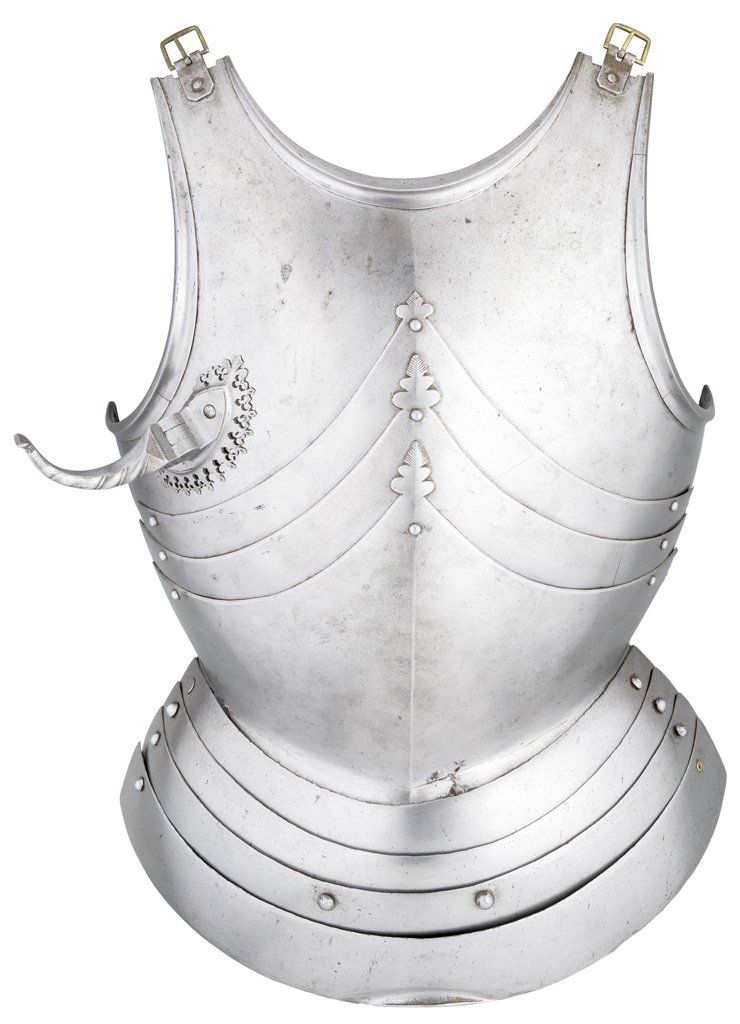
A plackart is a piece of plate armor that protects the tower half of the front torso. Plackarts were connected to the lower portion of the cuirass. They were predominant in the 15th century and stopped at the natural waist. To extend protection further, metal plates called faulds could be added to protect the hips and groin.
Eventually, plackarts evolved to cover more of the front of the armor, covering nearly the entire breastplate. This was more common in Italian armor. Cuirassiers and other armored cavalry used these in the 16th and 17th centuries to provide extra protection against firearms.
German Gothic-style plackarts were often fluted with straight edges in the armor for decoration and to make the armor stronger.
Culet
A culet is a piece of plate armor to protect the small of the back, consisting of small horizontal lames or bands of metal connected to the plackart, similar to the faulds on the front of the plackart.
Spaulder / Pauldron / Gardbrace

The spaulder is a single plate of armor covering the shoulder, but not the armpit, with bands of metal joined by straps of leather or rivets.
The pauldron is a component of plate armor designed to protect the shoulder, armpit, and sometimes parts of the back and chest. Pauldrons were larger than spaulders and typically consisted of a dome-shaped “cop” to cover the shoulder with multiple lames to defend the upper arm and shoulder and allow for flexibility when moving the arms.
A gardbrace is a plate of armor that covered the front of the shoulder and the armpit, usually worn over the pauldron for an extra layer of shoulder protection.
Besagew / Rondel
A circular plate that covers the armpit. A besagew, or rondel, was typically worn with spaulders. These protected vital arteries under the arms from slashing blows in hand-to-hand combat. Sometimes, instead of rondels, the wearer of armor would expose the chainmail under the armor.
Rerebrace / Upper Cannon
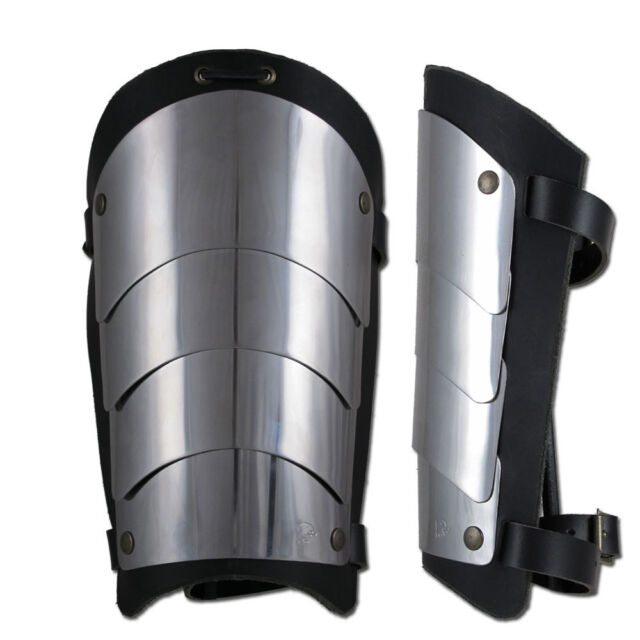
A piece of plate armor designed to protect the upper arm. The rerebrace covers the upper arm between the pauldron and the cowter or between the shoulder and elbow on the person wearing the armor.
Splint rerebraces were used as part of Byzantine armor in the early medieval period and re-emerged in England during the 14th century as part of full plate armor. They were typically constructed of overlapping lames to allow flexibility and movement.
Cowter / Guard of Vambrace
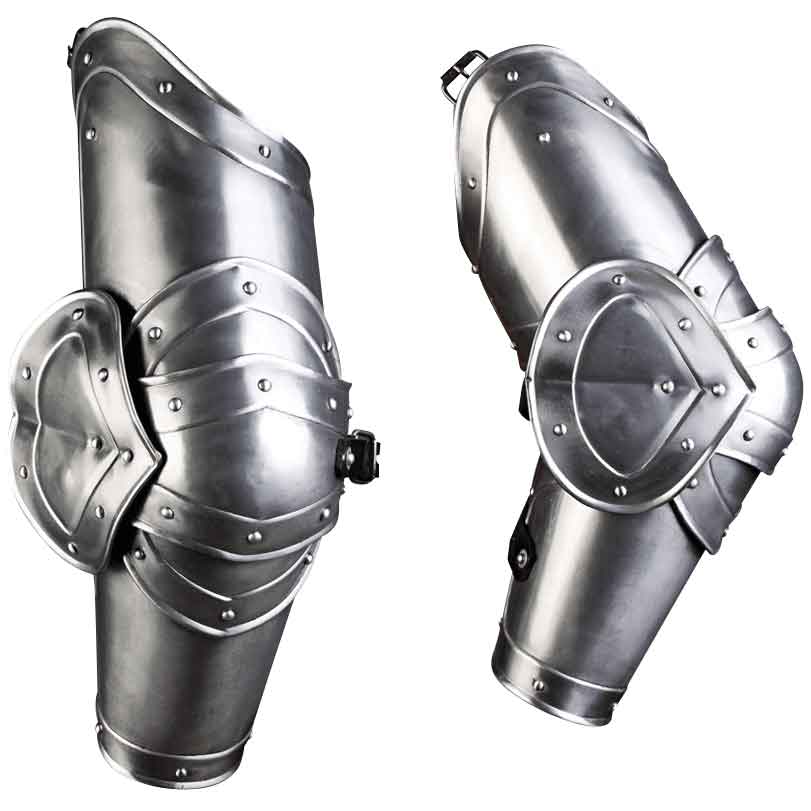
Plate armor defense for the elbow. A cowter was initially just a curved piece of steel. As plate armor progressed, articulated joints were added to the cowter.
A guard of vambrace was an additional layer of armor that went over the cowter, which included protection for the upper arm and forearm, by extending the armor to include the vambrace or rerebrace.
Vambrace / Lower Cannon
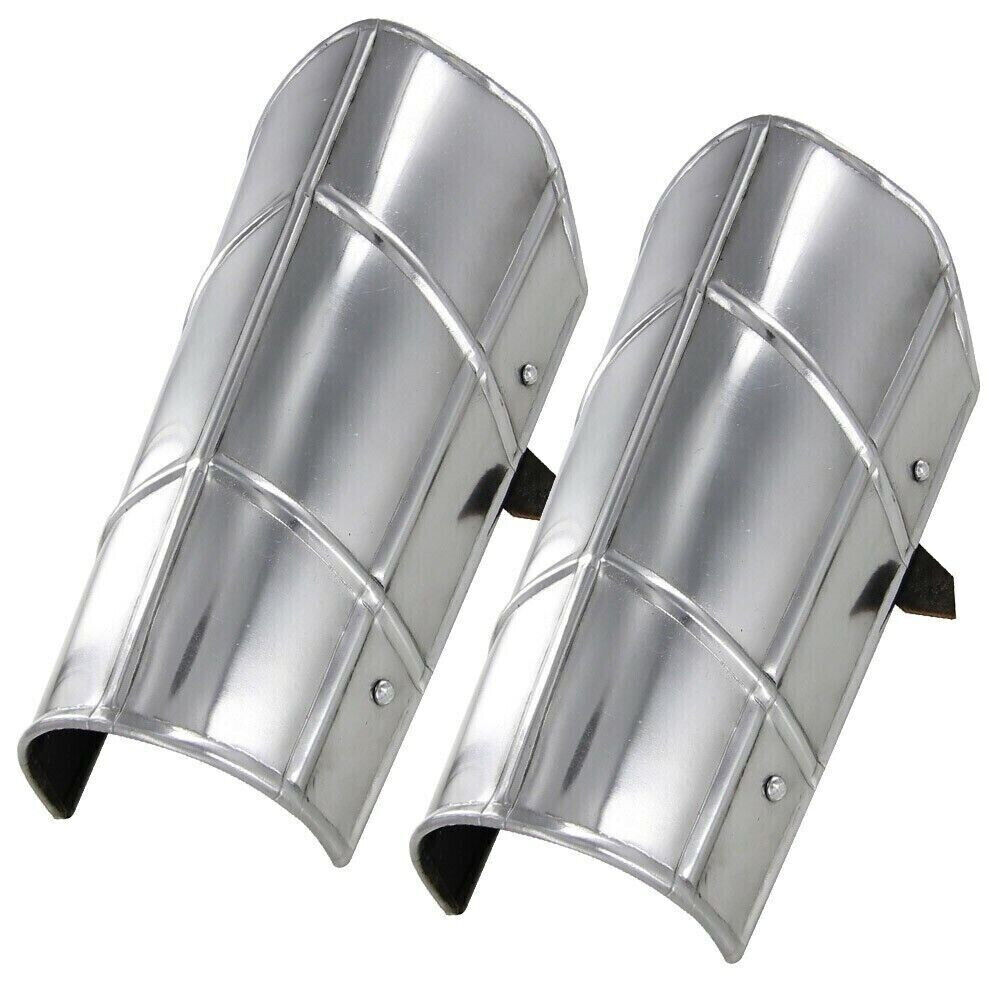
A piece of plate armor designed to protect the forearm. The vambrace originated from leather braces worn by archers to defend themselves from snapping bowstrings.
Vambraces evolved into leather splints of metal attached to a leather backing, and with the introduction of full plate armor, they were made of solid steel and connected to the cowter at the elbow and the gauntlet at the wrist.
Gauntlet
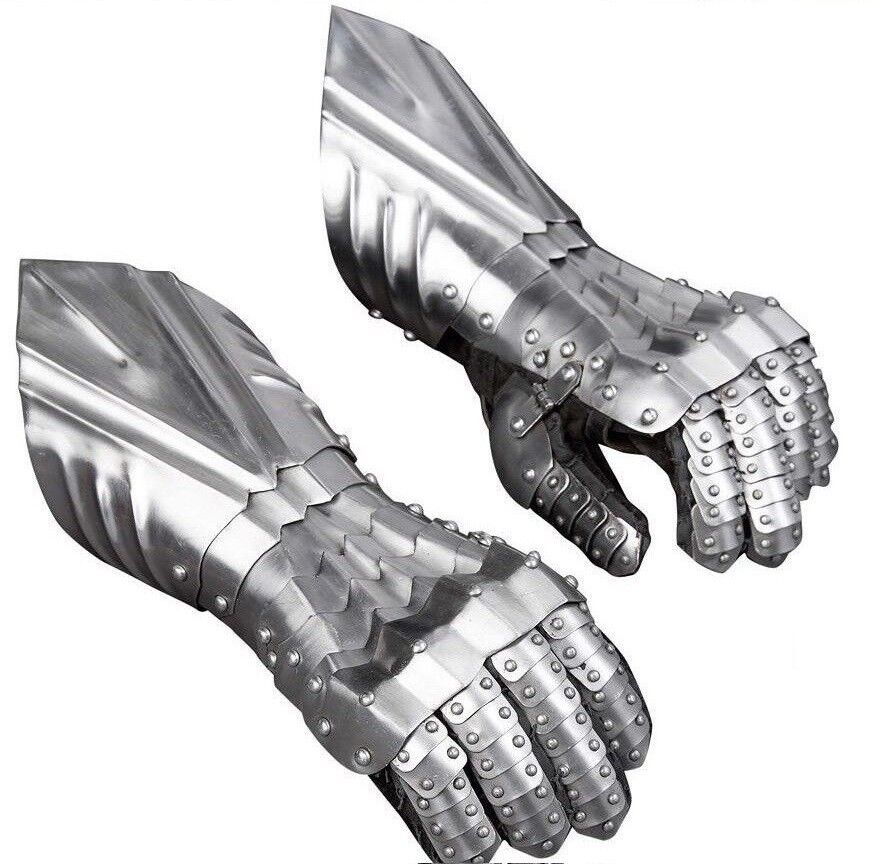
A type of glove that protects the hand and wrist. Gauntlets were used in Europe from the 14th century onwards.
In the 11th century, soldiers and knights wore chain mail with sleeves that hung to the elbow. In the 12th century, the mail grew longer with narrower sleeves, occasionally with muffs or chain mail mittens.
In the 14th century, armorers began to design fully articulated armor and protection for the hands. For the fingers, this included a series of lames or plates that formed the mitten and the fully-fingered glove, which permitted full use of all fingers. Lames provided the ability to bend the hand and fingers like a typical glove today.
To "throw down the gauntlet" is to issue a challenge. A knight would challenge a fellow knight or enemy to a duel by throwing one of his gauntlets on the ground. This was more ceremonial with the action of the King's Champion, who acted as the champion for the King at his coronation and would throw down his gauntlet and defend the King in the unlikely event that someone challenged the new King's title to the throne.
Tassets
A form of plate armor that protects the upper thigh. Tassets are separate plates of steel that hang from the bottom of the breastplate or faulds. From the 16th century onwards, tassets were sometimes used with cuisses to create fully articulated leg defenses from the waist to the feet.
Cuisse
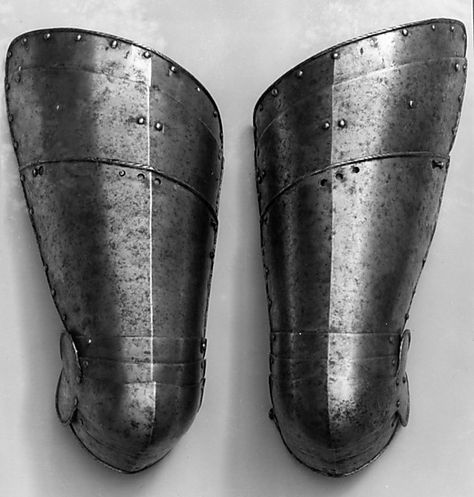
A section of plate armor that protects the upper leg and thigh. Cuisses were worn over the thighs to protect against blows to the legs. Padded cuisses were worn in the 12th and 13th centuries, usually over chausses (chain mail leggings).
Cuisses were sometimes attached to the poleyns, which protected the knees. In Europe, the cuisse only covered the front of the leg or thigh, while in England, they surrounded the whole leg to defend against attacks from behind.
Poleyn

A component of plate armor that covers the knee. Poleyns were among the first parts of armor to be developed during the transition from mail armor to plate armor.
Poleyns appeared around 1230 and stayed in use until firearms made them obsolete in 1650. Early poleyns strapped over mail chausses. In the 14th century, they began to attach to padded leggings or plate cuisses. The 15th century brought more changes as the poleyns comprised an articulated construction attached to the cuisses and greaves. They often included fins or a rondel to cover gaps on the side of the knee.
Greave / Schynbalds

The portion of plate armor that covers the front and back of the lower leg. The primary purpose of the greave is to protect the tibia or shin bone. The greave consisted of a hard metal exterior and an inner padding that absorbed any blow's impact on the lower leg.
Common until the 9th century, when they disappeared from use, they reappeared in the 1230s and were known as schynbalds that only protected the shin. Around 1290, greaves evolved to protect the front and back of the lower leg. They were made of two metal plates joined around the leg by hinges and straps.
Sabaton / Solleret

Part of a knight's suit of armor that covers the foot. Sabatons typically ended in a tapered point well past the toes. Later, the ending is at the tip of the toe but broader, forming the duckbill-style sabaton. The sabaton was made of riveted iron plates called lames, which usually covered only the top of the foot.
Sabatons were not generally worn during fighting on foot as the footwear would be too heavy and hinder movement, and feet were commonly never attacked in dismounted combat. The soldiers on foot would wear leather shoes or boots. Hopwever, sabatons were vital for knights on horseback.
Mail Coif
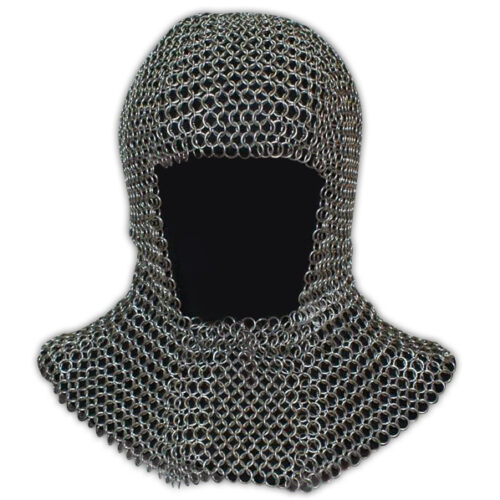
A mail coif is armor that dates from the 10th century and protects the head. It consisted of a flexible chainmail hood extending to cover the throat, neck, and top of the shoulders, exposing only the face.
Mail coifs were usually made in the 4-to-1 mail pattern where each ring is linked with four others. Despite what's depicted in movies, mail coifs were never placed directly on the skull but rather worn over a padded coif made of leather or cloth for extra comfort and protection. Mail coifs were sometimes worn under the iron and steel helmets that evolved when plate armor was introduced.
By the 15th century, the mail coif was replaced by the aventail, a curtain of chain mail attached to a helmet's skull.
Spangenhelm
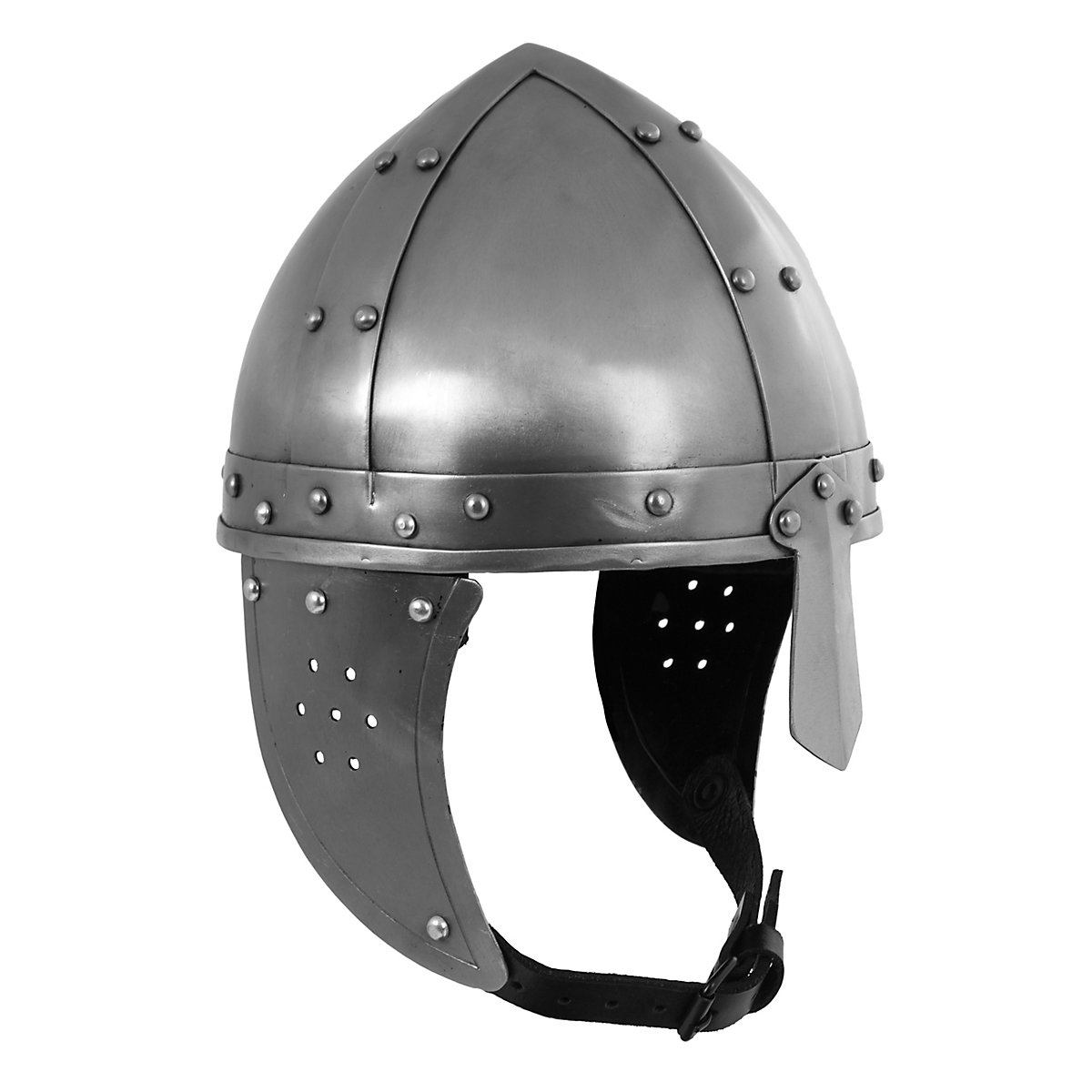
The Spangenhelm was used between the 4th and 11th centuries and was the standard choice during the early Middle Ages. It consisted of an iron frame with plates of metal, leather, or horn riveted inside.
The term spangenhelm is of German origin. Spangen refers to the metal strips that form the frame, and helm means helmet. The strips that make the frame connect to three to six plates, forming a conical shape to cover the crown of the head. Some helmets had hinged cheek guards and chainmail attached to the bottom to protect the neck, like an aventail. Over time, it gave way to helmets with a single-piece skull, such as the nasal helmet.
Nasal Helmet / Norman Helmet
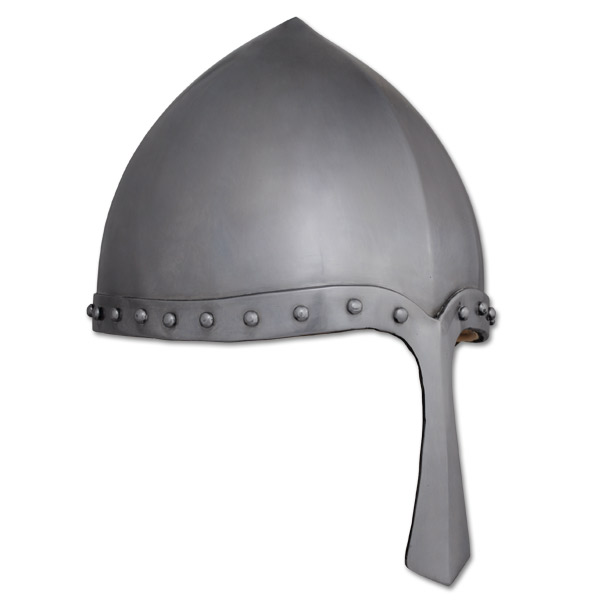
The nasal helmet was used from the late 9th century until the mid-13th century. The nasal helmet was based on the spangenhelm being conical in shape, but the skull portion was made of a single sheet of iron or steel instead of metal strips around a frame. The nasal helmets were characterized by the nose guard or nasal, a single metal strip extending down from the skull or browband over the helmet. This metal strip helped protect the face while not inhibiting the wearer's vision. Sometimes, the nose guard would be hinged to the helmet, allowing the wearer to raise the guard when not in combat.
Nasal helmets were worn over a mail coif to protect the neck. The nasal helmet was also padded for comfort and a secure fit. The nasal nose guard was sometimes so large that the wearer was unrecognizable. At the Battle of Hastings in 1066, William the Conqueror had to lift his helmet to show that he was still alive when rumors spread that he had been killed in battle, as his nasal helmet prevented him from being recognized by his men.
Kettle Hat / War Hat

A type of helmet made of iron or steel, the kettle hat consisted of a round shell covering the head with a brim around the bottom edge of the shell, providing extra protection to the wearer against blows from above. It gained its name from its resemblance to a metal cooking pot.
Early kettle hats were made like the spangenhelm with a metal framework lined with metal plates. Over time, these evolved into hats made of a single metal sheet. The kettle hat was easy to make and cheaper than other helmets. It was primarily used by infantry but also occasionally by cavalry and men-at-arms. The kettle hat did not interfere with the wearer's vision, hearing, or breathing.
When steel helmets reappeared in World War I, the kettle helmet was reincarnated as the British Brodie helmet (tin hat).
Enclosed Helmet
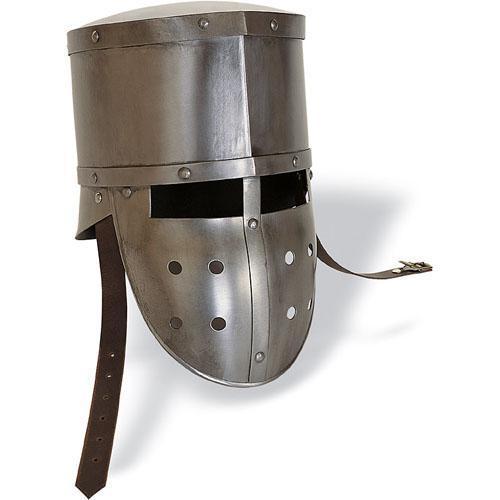
The enclosed helmet, used between the 12th and 13th centuries, was the forerunner to the great helm. It covered the entire head with deeper coverage for the side of the head than on earlier helmets and completely protected the face.
It likely evolved from the nasal helmet, which by the 12th century had a flat top instead of conical. The enclosed helmet was created by adding a face plate, which contained openings for sight and breathing, and by extending the back and sides to produce a cylinder-shaped helmet.
The enclosed helmet would have been worn over a mail coif and padding under that to help absorb any blows to the head. It was used primarily by knights, who did not like the limitation of vision caused by the face plate, so nasal helmets and kettle hats continued to be used simultaneously.
Great Helm / Barrel Helm
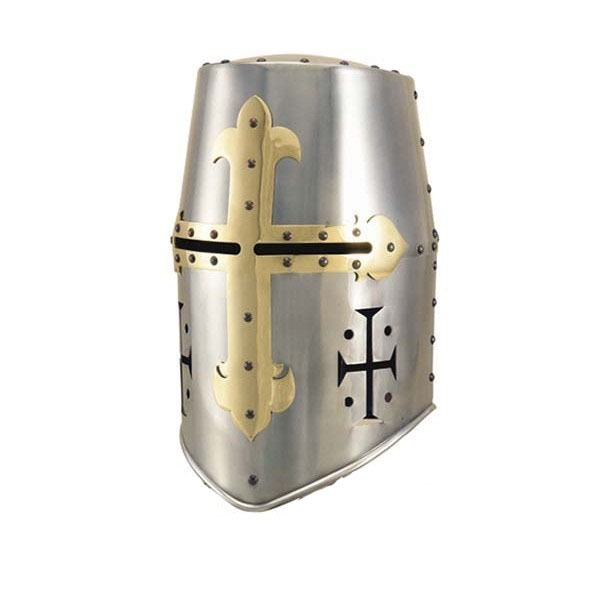
Great Helms rose to prominence in the late 12th century during the Crusades and were used by knights in most armies from around 1220 to 1350. It was a flat-topped cylinder of steel that completely covered the head with only small slits for vision and openings around the cheeks for ventilation. Sometimes, the helmet would not be flat-topped but rise to a point, making a cone shape. These were called Sugarloaf helms and helped deflect the impact of a blow to the head better than the flat surface.
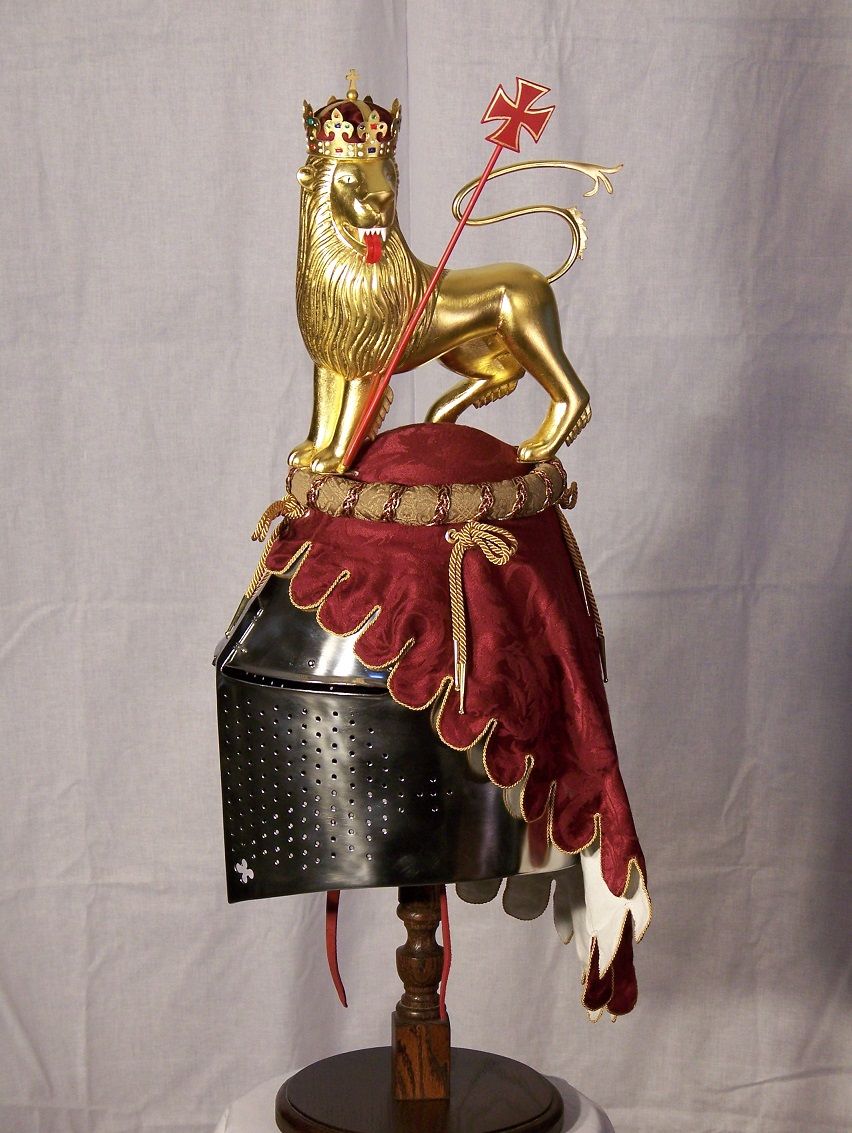
Great helms could be worn in conjunction with chain mail over a mail coif or with plate armor. These helms were often decorated with small holes for air made in the shape of crosses. The visor area for the eyes and nose could also be plated, forming a cross-design decoration. Around 1600, great helms became popular in funerals where the helm would be topped with a crest forming a crown, lion, or some other symbol of heraldry.
While protecting the whole head, the great helm was heavy, limited a knight's vision, provided little ventilation, and could overheat in hot weather. It fell into disuse in the 15th century during battles but was still used in jousting tournaments, where it evolved into the frog-mouthed tilting helm. Jousting great helms would not have ventilation holes on the left side of the face but a smooth surface, so lances would deflect away if a knight were struck in the head.
Cervelliere
A close-fitting skull cap of steel or iron. It was worn as a helmet during the medieval period. A version known as a "secret" was worn under felt hats during the Wars of the Three Kingdoms. The cervelliere was usually worn under a mail coif. By the 13th century, wearing a cervelliere under the great helm was common practice.
Bascinet / Hounskull

A 14th century open-faced medieval helmet. The bascinet evolved from the skullcap but extended downwards on the sides and back to protect the top of the neck and rose to a point atop the skull. An aventail was usually connected to the helmet's lower edge to protect the neck and shoulders further.
By 1330, a visor was often attached to the front to protect the face. The visor was connected by side-mounted hinges in England and a brow-mounted hinge in Germany. This allowed the visor to be raised for better vision when not in battle. Around 1350, French bascinets were used in conjunction with a bevor attached to the breastplate to protect the neck and chin. The visor would rest flush on the bevor to create a complete face guard.
From 1380, the visor was enlarged and drawn out at the nose in a conical shape to deflect blows to the face better. This style of bascinet was called the hounskull. In the 15th century, the aventail was replaced by a metal gorget, giving rise to the "great bascinet."
Sallet
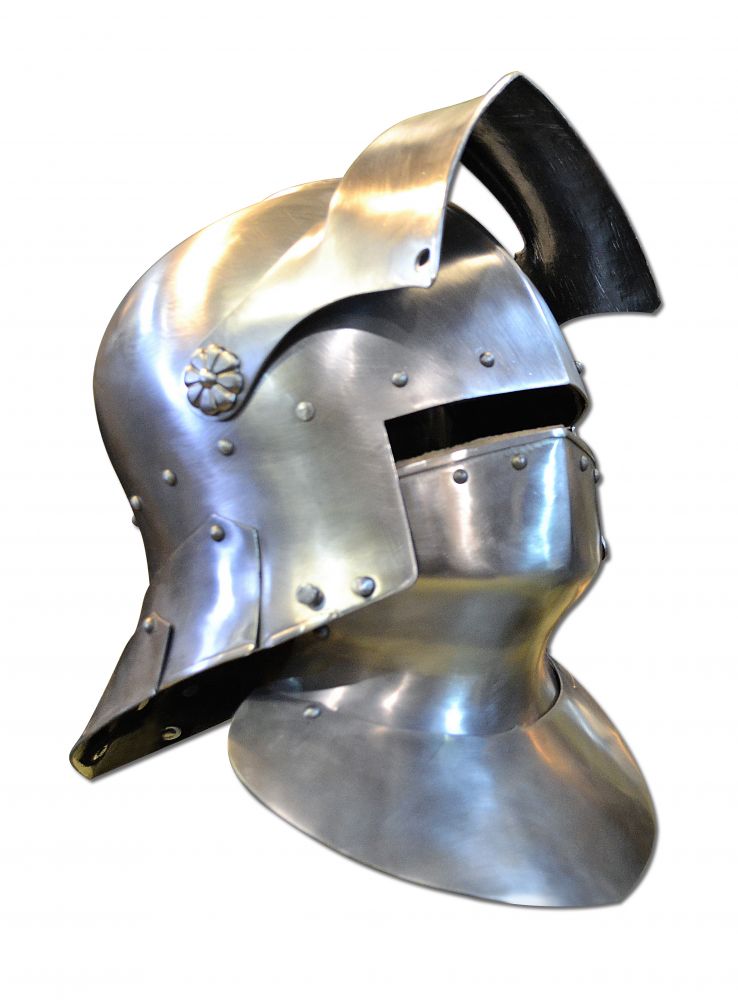
A combat helmet that replaced the bascinet during the mid-15th century. The armet was also popular in Italy, France, and England, but the sallet was almost exclusively used in Germany.
The earliest sallet helmets evolved from the bascinet without a visor or aventail. The sallet was curved to a flange in the back to protect the back of the neck, and the front of the helmet was drawn forward below the level of the eyes to protect the cheeks. Other versions had the same shape, but the upper face was covered by a movable half-visor, which could be raised when not in a battle for a more straightforward vision.
German sallets were often worn with a scoop-shaped gorget called a bevor that was attached to the chest plate and protected the nose, chin, and throat. There were no ventilation holes as there was a gap between the sallet and where the visor overlapped with the bevor.
Barbute
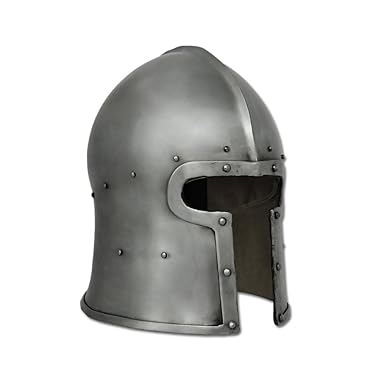
A 15th century visor-less war helmet with a distinctive "T" or "Y" shaped opening for the eyes and mouth. The barbute resembles the classical Greek helmets of antiquity. It is considered to be a specialized form of the sallet.
The main characteristic of the barbute is the extension of the sides of the helmet towards the nose, protecting the sides of the face under the eyes. The Y-shaped version incorporates a nose projection down from the helmet's brow.
Barbutes were usually made from a single sheet of metal. Barbutes from the Italian Renaissance period were made of iron with steel that was heated and quenched to give it a hard outer surface with an inner surface that prevented shattering.
Armet
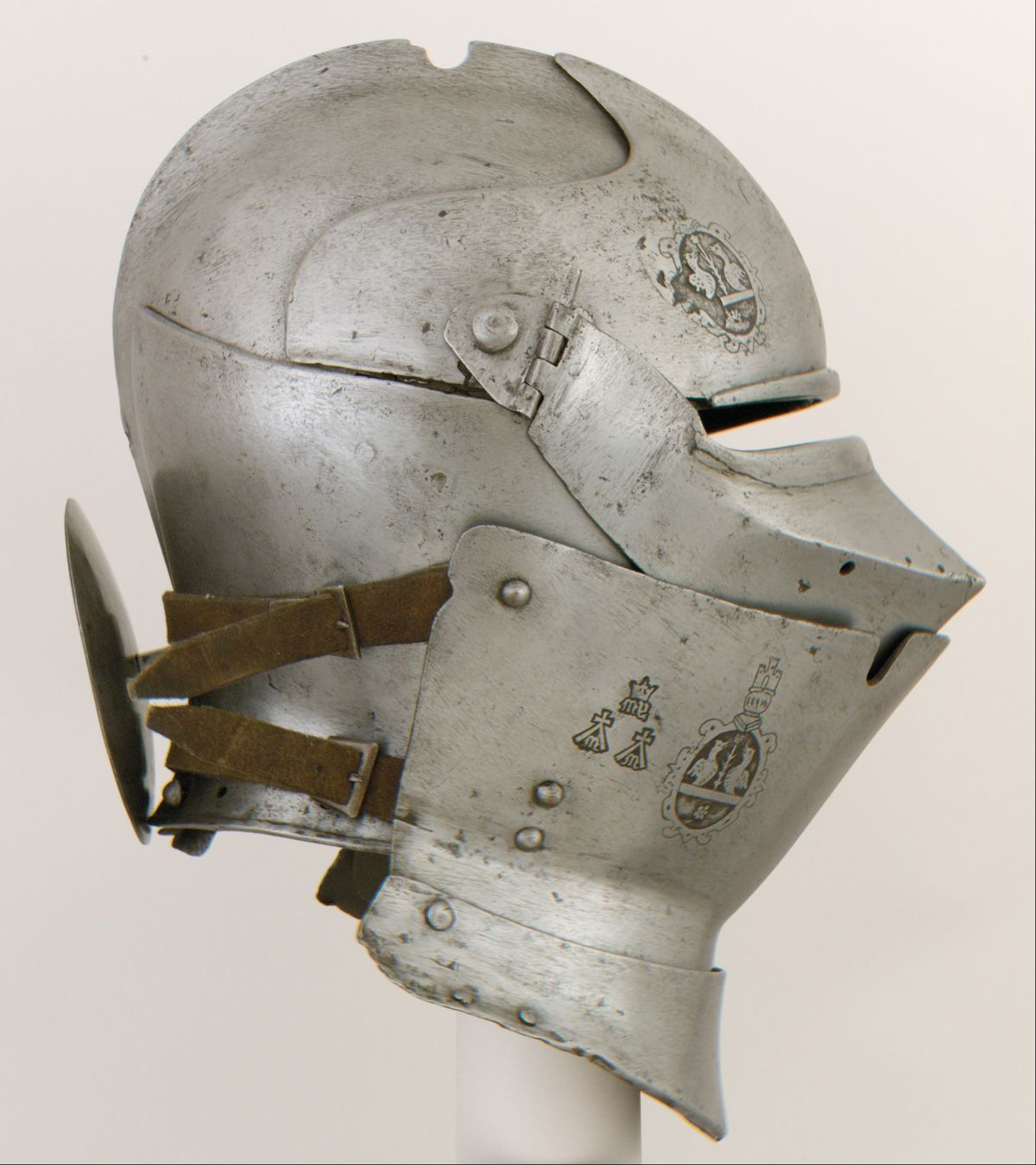
A 15th century combat helmet that enclosed the entire head. The armet was used by a man-at-arms in full plate armor. It consisted of four pieces: the round skull cap for the top of the head, two large hinged cheek pieces that locked at the front of the helmet over the chin, and a visor connected at the sides of the skull piece to allow the visor to be opened and closed while the helmet was worn. Sometimes, a wrapper was added to protect the front of the neck, which was attached to the helmet by leather straps.
The armet had a narrow extension to the back of the skull, reaching to the nape of the neck. From 1515, a new form of armet was produced in Germany where the skull piece extended further down the back of the head and as far forward as the ears. This allowed the cheek guards to open sideways on vertical hinges connected to this broader neck extension.
The armet was most popular in Italy and widely used in England, France, and Spain. While in Germany, the sallet remained the helmet of choice.
Close Helmet / Close Helm

A medieval combat helmet used by knights from the 15th to 17th centuries. Plate armor reached its pinnacle with the development of the close helm, resulting in the traditional knight in shining armor.
Like the armet helmet, the close helmet enclosed the entire head and neck. It differed from the armet as it did not have cheek guards that opened laterally, fastening in the front.
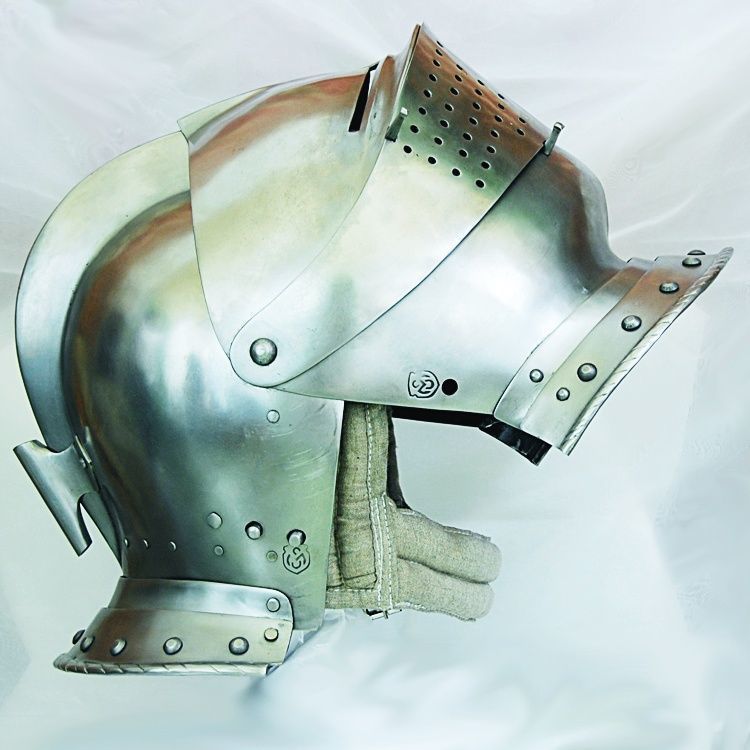
Instead, it opened vertically using an integral bevor attached to the helmet using the same pivots as the visor. This allowed the helmet to be opened vertically along the neck to allow the head to fit into the helmet since the neck portion was narrower. It also allowed the visor to be raised and lowered while wearing the helmet. Pivot hooks secured the bevor and visor. The bevor was also often held in place with additional leather straps.
Around 1520, the close helmet included a split visor with independent pivoting parts. The bottom half, or upper bevor, was called a ventail. Above that was the upper visor, which covered the eyes and could be raised separately from the ventail. This combination made it possible to raise the whole visor when not in combat for better vision and breathing or just the upper visor for better vision while still protecting the face. Both parts would be closed during hand-to-hand combat.
Burgonet / Burgundian Sallet

A Renaissance-era open-faced bowl-shaped helmet with a peak, collar, and characteristic keel-like crest comb along the top ridge of the helmet. Sometimes, cheek guards would be attached that only protruded enough to protect the cheeks, not the nose or mouth.
As battles evolved to include gunpowder, hand-to-hand combat with swords and daggers became secondary; thus, the need to protect the face also declined. The burgonet was significantly cheaper to make, had fewer hinges and locking mechanisms than the close helm, was not as heavy to wear, and provided better vision and breathability. These advantages offset the sacrifice in protection.
To protect the face, burgonets could also have a falling buffe, like a bevor that could be drawn up to protect the face rather than drawn down like a visor.
The burgonet was common in Europe in the early 16th century. Cavalry, cuirassiers, and hussars mostly used them. Border Reivers, or raiders of the English-Scottish borders, were also fond of burgonets.
Buckler / Lantern Shield
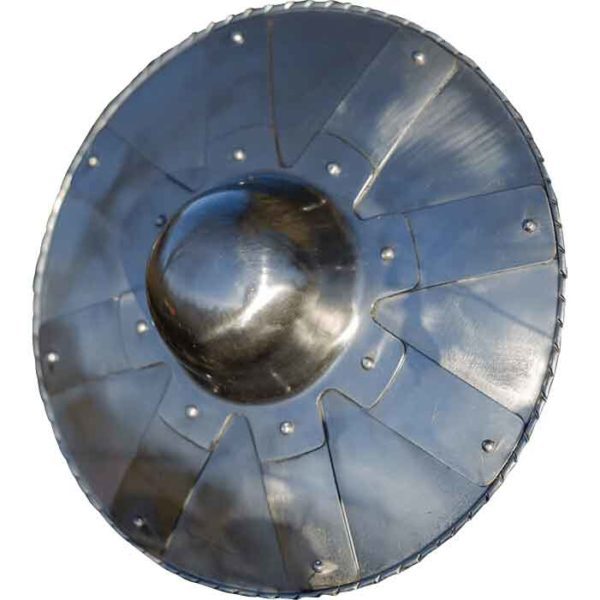
A small shield, up to 18 inches in diameter, gripped by a central handle on the back behind the boss. The buckler helped deflect the blow of an opponent's strike, binding his arms or striking him with the buckler. It was used between 1100 and 1600 in conjunction with a sword.
A lantern shield was for night duels during the Italian Renaissance. It consisted of a buckler combined with a lantern or a hook for a lantern intended to blind the opponent at night. It is thought that the lantern shield was never used in combat but was for patrolling Italian city streets at night. Some examples of the lantern shield included sword blades or spikes, adding an offensive thrusting or slashing feature to the shield.
Heater Shield

A form of European medieval shield that evolved from the kite shield in the late 12th century. The kite shield protected soldiers' legs on horseback, but plate armor grew to include the protection of the legs, making the more extended kite shield less critical.
The heater shield was smaller than the kite shield and more manageable, so mounted or foot soldiers could use it. Heater shields were made of wood, braced with steel or iron, and covered in leather. They were held by a combination of a hand strap and a belt called a guige, which wrapped around the neck. The guige also allowed the shield to be hung around the wears back when not used for combat. The shield was used by every class of society in medieval Europe, from knights to peasant soldiers, as they were inexpensive to make and provided a large surface area for defense.
The term heater shield is a modern term and gets its name from Victorian times due to its shape resembling a clothes iron. This style of shield is often used for heraldic display or the display of a coat of arms.
Kite Shield

Large almond-shaped shields, rounded at the top and curving down to a point at the bottom. The kite shield was used by mounted cavalry to protect the rider's thigh, as circular shields like the buckler provided little protection to a rider's left flank.
Kite shields appear in the Bayeux Tapestry, tying the shield to Norman warfare. During the First Crusade, Arab and Byzantine soldiers first observed the kite shield being carried by Norman crusaders, which left such an impression on the Byzantium that they replaced all their round shields with kite shields in the Komnenian army by the mid-12th century.
A typical kite shield was at least 3 feet long, constructed of wood, and sometimes included stretched animal hide and iron components. Because of the shape of the shield in contrast to the round shield, they were equipped with leather gripping straps that fastened to the arm and kept the shield in place even when the arm was relaxed.
Pavise / Pavesen

An oblong shield used between the 14th and 16th centuries. Archers predominately used the pavise shield, which was large enough to protect the entire body. During a battle, an archer would crouch down behind the pavise shield for protection while they reloaded their weapon. The pavise shield was large, square, convex, and had a prominent central ridge. The shield was often held in place by a spike in the bottom that drove into the ground.
Using a shield to protect an archer dates back to the writing of Homer's Iliad, where Ajax used a shield to cover his half-brother Teucer, who would peer around the shield and shoot arrows.
Round Shield / Targe
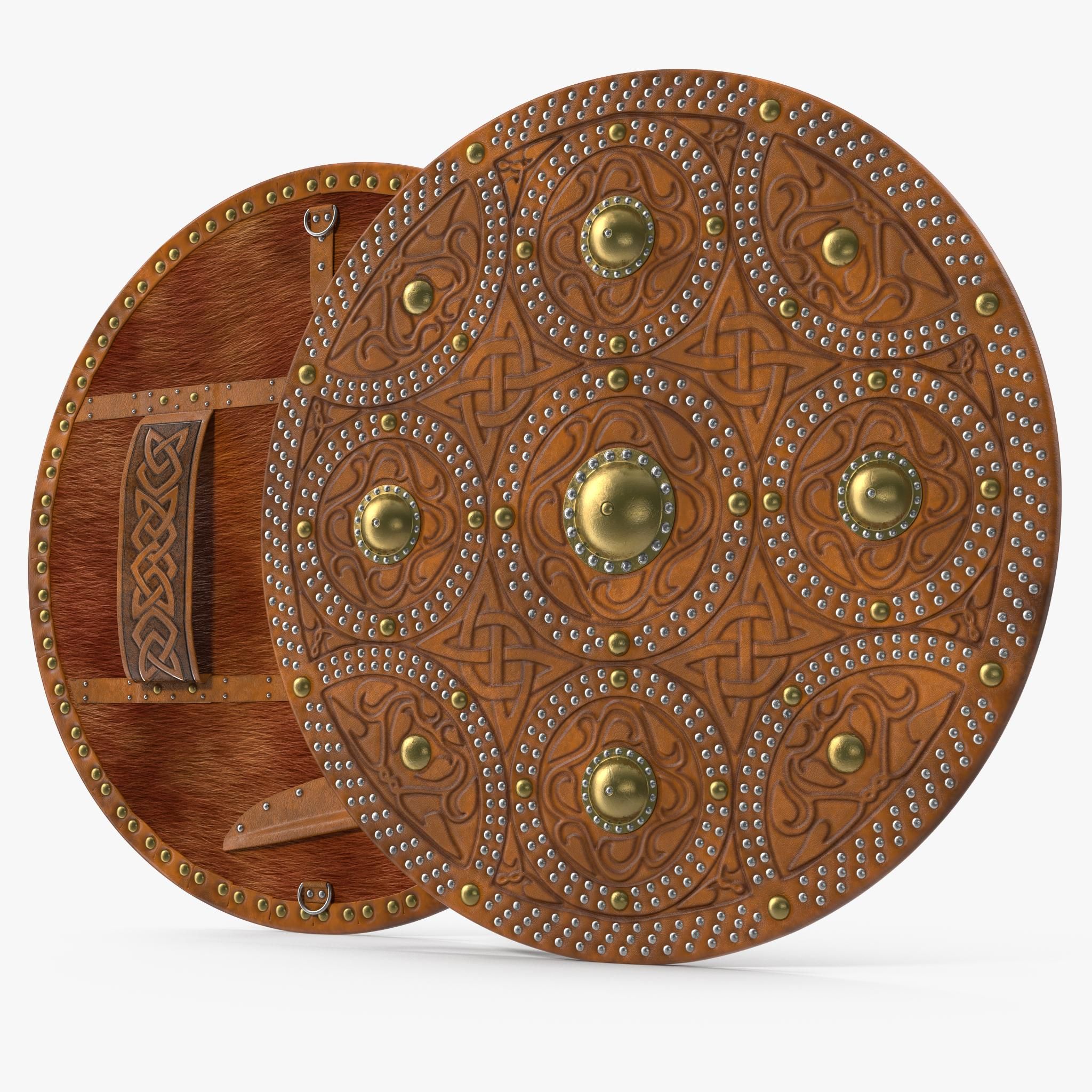
A round concave shield, generally between 18 and 21 inches in diameter, with two leather straps on the inside. One strap was adjustable for fastening to the forearm; the other was fixed as a grip for the hand. Targes were usually made of wood, iron, or iron-plated wood.
The Scottish targe was a Highlander's primary means of defense from the 16th century until the Battle of Culloden in 1746. The inside of the targe was formed from two thin layers of wood with the grain of each layer at right angles from the other and fixed together with wooden pegs. The front was covered in a tough cowhide, often decorated with Celtic patterns, and had center bosses of brass. The back was usually covered in deerskin or sometimes red cloth taken from the uniform of a redcoat they had killed in battle. Following the Battle of Culloden, Targes were banned in Scotland as part of the Disarming Act, and many were destroyed. Those that still exist are usually decorated with intricate designs, indicating important people owned them.
The term targe is also used to describe special shields used for jousting.
Scutum
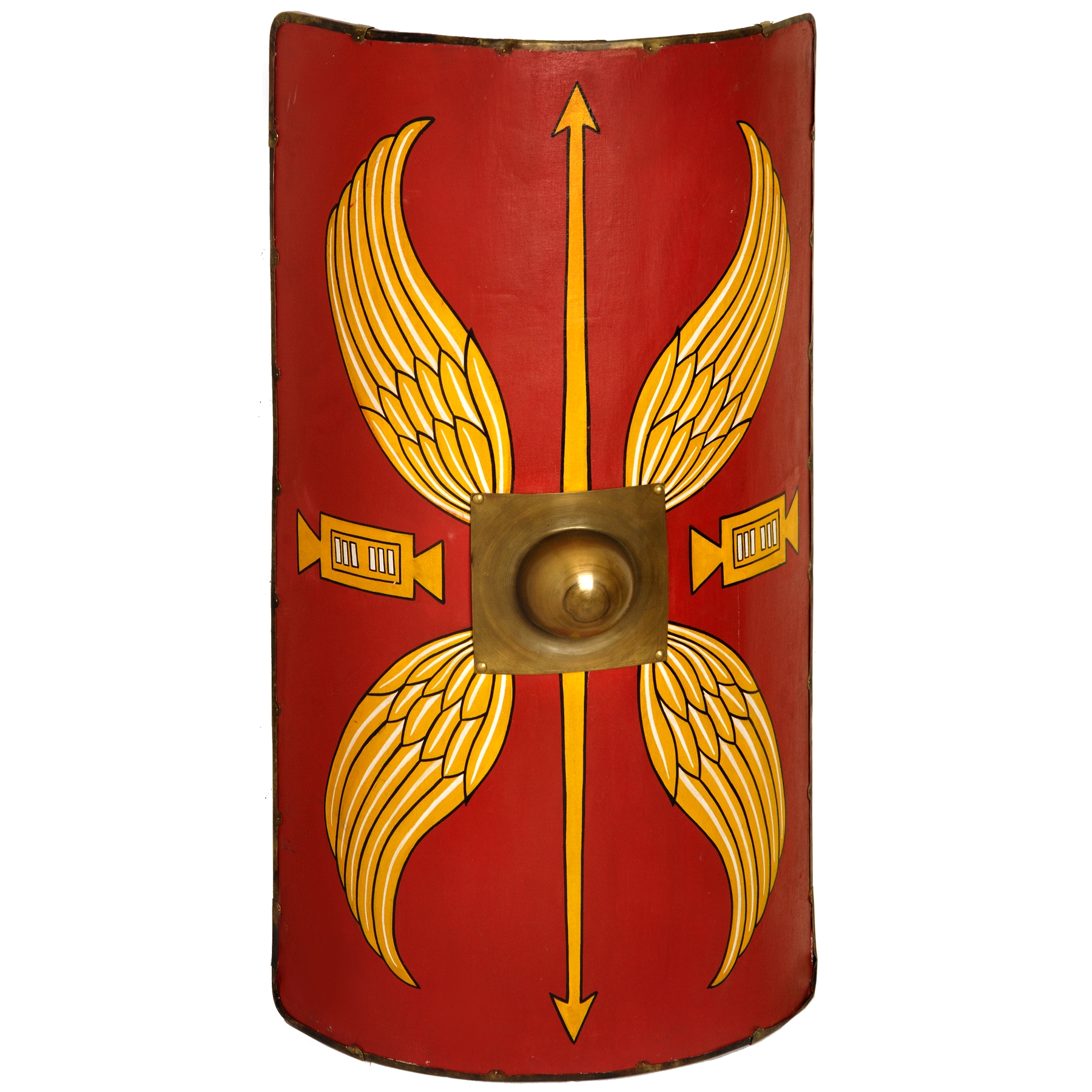
A type of shield used by the Italic people of antiquity, most notably the Romans in the 4th century BC. The scutum was a large rectangular curved shield made from thin sheets of wood covered with canvas and leather and a spindle-shaped boss. They were light enough to be held with one hand, and their height and width still protected the entire bearer.
The Romans used the scutum to protect individual soldiers. Still, as a group, they would align in packed formations of legionnaires who would overlap their shields to form a shield wall, protecting them from descending projectiles. This tactic evolved into the testudo, where they added legionnaires behind the shield wall who held their shields above, forming a turtle shell-like formation of shields. Roman soldiers would have swords sticking out between shields to thrust into the enemy while being protected by shielding the wall.